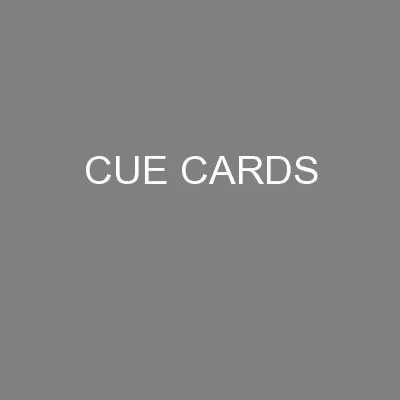

How to make and use them effectively Courtesy of writeoutloudcom Why Use Cue Cards The answer is simple If you are not relying on a wordforword text you are free to interact with your audience You are able to look around and gesture You will sound look and feel more present more ID: 472111
Download Presentation The PPT/PDF document "CUE CARDS" is the property of its rightful owner. Permission is granted to download and print the materials on this web site for personal, non-commercial use only, and to display it on your personal computer provided you do not modify the materials and that you retain all copyright notices contained in the materials. By downloading content from our website, you accept the terms of this agreement.
Slide1
CUE CARDS
How to make and use them effectively
Courtesy of write-out-loud.comSlide2
Why Use Cue Cards?
The answer is simple. If you are not relying on a word-for-word text you are free to interact with your audience. You are able to look around and gesture. You will sound, look, and feel more present; more
in the moment. Slide3
How to Make Cue Cards
The Best Cue Cards:
Have ONE main heading or idea per card
Are written clearly using larger than usual font (so you can read them easily).
Have plenty of white space around each word or phrase to help them stand out.
Use bullet points or numbers to itemise the supporting ideas under the main heading. Slide4
How to Make Cue Cards
Are written one ONE side of the card only.
Are clearly numbered so that you know the order they come in.
Are clearly initialed incase they get lost we can return them.
Are
color-coded
clearly showing your main idea, supporting ideas, and examples.Slide5
Writing up Your Cue Cards
Create an outline on paper before attempting to use your cards.
You should have between 10 – 15 cue cards.
Introduction
Main Points
Supporting Details
ConclusionSlide6
Colour
Coding Your Cue Cards
BLUE
for Main Ideas
RED
for Supporting Ideas
GREEN
for quotes
PURPLE
for important facts
ORANGE
for transitions
**It may be wise to write them in pencil first, then go over them in
colour
. **Slide7
Numbering and Initialing
your Cue Cards
Don’t forget to number and initial each cue card in case they get lost or out of order. Numbers and initials go in the TOP
RIGHT HAND CORNER.
You may also wish to write which part of the speech the card is for:
introduction, main point 1, main point 2, conclusion, etc.
THIS GOES IN THE TOP LEFT HAND CORNER.Slide8
Double Check!
Double check the effectiveness of each card as you write them to make sure you are using keyword or phrases that actually do trigger your memory. This is particularly important for links or transitions. Forgetting how you got from one piece of information to the next will leave you stranded. Slide9
Rehearsing with your Cue Cards
Writing is only part of the process. It’s delivery that completes it.
Step 1 – Start by using your cue cards to run through several times out loud. This is to familiarize yourself with the flow. Don’t worry about expression or gesture. Have a friend time you. Complete this task a minimum of 3 times. Recording your time, each time.
Step 2 (Optional) – Practice with the flip camera. This time focus on delivery. Have a friend film and time you. Slide10
Rehearsing with your Cue Cards
Step 3 – Meet with 3-5 friends. Have them watch for:
fiddling, standing awkwardly, tugging at your clothes, etc.
irregular breathing
Racing your speech
Pauses or breaks in the wrong places
Specific words or phrases that trip you up
Holding your cards in a way that masks your face
Fiddling with your cards
Projection and Intonation
Eye contact
Smiling
Pace